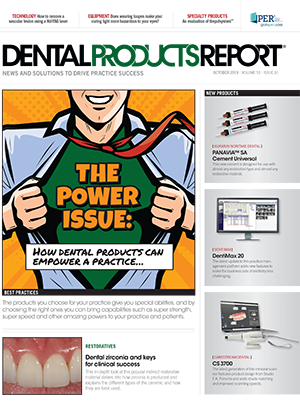Managing the power dynamic of the workplace
How having the right people in the right places can give your practice superpowers.

Like Batman, Iron Man gets his superpowers from his intelligence. But Tony Stark has something with which Bruce Wayne struggles: People skills.
That trait is especially useful when managing a team of unique personalities and responsibilities: Like The Avengers-or the practice’s staff. Finding the right balance of responsibilities within the practice is a good way to get the best out of that staff.
Trending article: What is your superpower?
Roles
The size of the practice can affect the power dynamic. Single-location practices will have a different power structure than a practice with two or three locations. That dynamic changes when the practice is a DSO.
“The biggest thing for me when I think about power dynamics in the office is really the type of practice,” Dr. Goodchild says. “Let’s talk about a small mom and pop shop: It’s usually a single dentist, single hygienist, small practice, three or four chairs. You probably still have that kind of a dynamic, which is the dentist being the de facto leader, potentially having an office manager that handles the operations of the dental practice, but the dentist becomes sort of a leader. Maybe it’s single dentist owner, but that is changing, dramatically.
“We are seeing a huge uptick in group practice models and then into a DSO structure,” he continues. “And the hallmark of a DSO structure is decentralized operations, which is that you have part of the business that supports the practice. And that supporting organization could be staffing, marketing, operations, procurement-there are lots of different things. So as practices grow, you’re not a mom and pop shop anymore. For instance, maybe you’ve got five practices. Now, a single dentist can’t really run that. They may have a director or an office manager, where somebody can oversee all of the practices.”
Ultimately, Dr. Goodchild emphasizes that patient care should be the ultimate goal.
“At the end of the day, I think if we focus on the patient’s care and experience as a driver towards a healthy business, then forces align for business success and growth,” he says. “That’s where it has to be. I don’t care if you’ve got 700 offices or just one office. If you don’t provide excellent care and customer experience, dental businesses don’t survive.”
Gender roles can play another factor in that power dynamic, but times seem to be changing.
“In an historical sense, it used to be there were a lot of male dentists and there were a lot of female hygienist and a lot of female assistants,” Dr. Goodchild observes. “And so you have this paternal figure, this is a male figure, as the leader, but that is really not what it is now. And that’s a good thing. I think that lots of different people are in all these different roles, so it’s not that way anymore. There are male hygienists, so the gender thing is going away, and I think that’s great.”
Trending article: 3 reasons you should cross train your team
The right people for the right job
Having the right people in the right roles is key to the practice’s optimal power structure. There are, of course, core jobs for which staff is hired. However, those roles can be dynamic and evolve, based on the staff’s competencies and the practice’s needs.
“I am a big fan of people that know what they’re doing and can do it right,” Dr. Flucke says. “And then just let them get out, let them do that job, get out of their way and let them do what it is they do. For example, we have one dental assistant in my office that we kind of dedicate to the overflow of the office. And those are things like sending in crowns and bridge, doing denture adjustments, taking impressions, things like that.
"That position is sort of what I call a Super Assistant, because that employee operates with more autonomy, because they’ve got a higher level of education and in a higher degree of clinical skills, and so that helps my office run a lot smoother when somebody can come to me and say, ‘The patient is here to have crown number 30 cemented. I’d tried it on. It fits well. I’ve adjusted the contacts a little bit, everything looks perfect. I just need you to come in and bless it so that we can get this thing submitted.’ As opposed to the old days when I would have to go in, do all of that myself and make all of those judgements myself.
“The other part of it is that I designate some of my staff members to be the repair people,” he continues. “Most offices do have one or two people that are really mechanically inclined, and there’s no reason that the doctor has to fix everything, or that if it’s a simple fix, that somebody needs to call a third-party that costs you more. There are a lot of folks out there that can do those kinds of things. We fluctuate between 10 and 12 employees in my office, and almost everybody has one or two little niches that they are responsible for that they enjoy. It gives them a lot more job satisfaction than just showing up and doing the same thing every day.”
